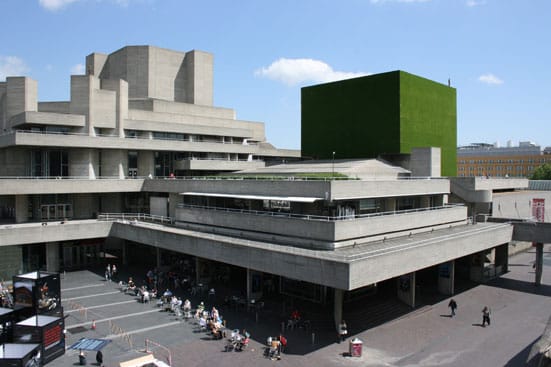FlyTower by Heather Ackroyd & Dan Harvey
Address: National Theatre, Lyttelton, South Bank, SE1 9PX
Dates: 10 May - 17 June
Interview with Heather Ackroyd & Dan Harvey
AM: What does the National Theatre mean to you as a site? I've read
that it tops both lists of the 'Most Hated' and 'Most Loved' buildings
in London.
HA & DH: We like the fact that the building is
controversial. The Lyttelton Flytower to our minds is the most iconic
architectural structure in London. It is completely enigmatic. Like a
massive sealed vault. Denys Lasdun the architect talked about urban
landscape, and apparently was inspired by burial mounds, along with
geological strata, hill terraces, recessed spaces. The concrete is like
bones. The building has platforms and terraces and people look as
though they are on stages.
AM: How did the idea for this project develop?
HA & DH: We had ideas about working on it back in 1991. We were
approached by associate theatre director Katie Mitchell in 2003 and she
was working on a version of Strindberg's Dream Play - she asked if we
would be interested in growing the tower (Heather worked with Katie as
a performer in 1995 on a Strindberg play for RSC.) Water was key
logistical problem, last May the project was postponed, it had been
scheduled to open September 2006, because of anxieties about drought
orders being implemented. In fact, the NT for decades has been pumping
excess floodwater from the basement into the drains, the water was
analyzed, found to be fine, and pipes laid and a pump gets the water up
to us on the FlyTower. The NT is using this water now for secondary
purposes in the building - flushing loos, washing machines, dying
fabrics. Saves them quite a few thousand pounds a year.
AM: The work is very ambiguous and conjures up many
conflicting references. It makes me think of the 'guerilla gardening'
movement but on a grand scale. Something about the groomed look of the
grass also recalls a quintessentially 'English' tennis lawn. I find it
tempting to see this work as foreshadowing a time in a post-human
future, the result of man-induced climate-change, when nature has taken
over the city's fabric and turned it back into organic matter. How do
you see the work now it has been realised successfully?
HA & DH: We see it as seed and clay, water and light.
Elemental. It is a messy, physically exhausting thing to do. Lawn is an
established sod-based medium. We don't describe our work in this way.
The seedling grass is altogether lighter, gravity defying. We work with
the seed and first shoot. We never cut the blades. It eventually
succumbs to decay and death. On one level, it acts out a simple
transformation of the concrete structure, it is playful, living,
subversive. But there is a subtext to the work that suggests the epic
drama of climate change that is unfolding before us. Some of the seed
we use has been prepared by scientists for its drought-resistant
characteristic. For when the climate gets too unpredictable.
Our large architectural works challenge the building mass and subvert
expectations of a familiar growing medium. The work presents the viewer
with a shifting landscape of colour, growth, texture, tonality, decay
and degradation. It presents an abstract canvas that perceptions and
preoccupations can be projected on.
There is something about the fragility of the work, a thin film of
vertical life, that provokes questions. It is a catalyst. A perverse
form of horticulture.
A book written in Victorian times called After London deals with a
dystopian view of the city after an apocalypse when roads are cracked
by weeds and brambles. But we don't hold interest in the dystopian
fantasy. More inspired by current thinkers and activists who are
challenging existing paradigms and provoking new thinking and ideas.
AM: Do you feel your work is in dialogue with Antony Gormley's figures on the surrounding buildings?
HA & DH: The postponement until this May caused the clash
with the Gormley installation. Any work that happens in the exterior
space will be subject to conflicts, be they environmental or otherwise.
The Lyttelton stage has been made exterior, and something is being
played out. The Gormley figure on our artwork draws polarised
responses, but it is part of the conflicting and ambiguous references
you mention. Given the context of the NT it seems ironically relevant.
Ambition, territory, cultural clash, environment, man. Theatre or life
in the making.
AM: How does it work making art as a duo? Do you ever disagree?
HA & DH: Of course we disagree, but we never take each other too seriously.
AM

Heather Ackroyd & Dan Harvey
FlyTower
2007